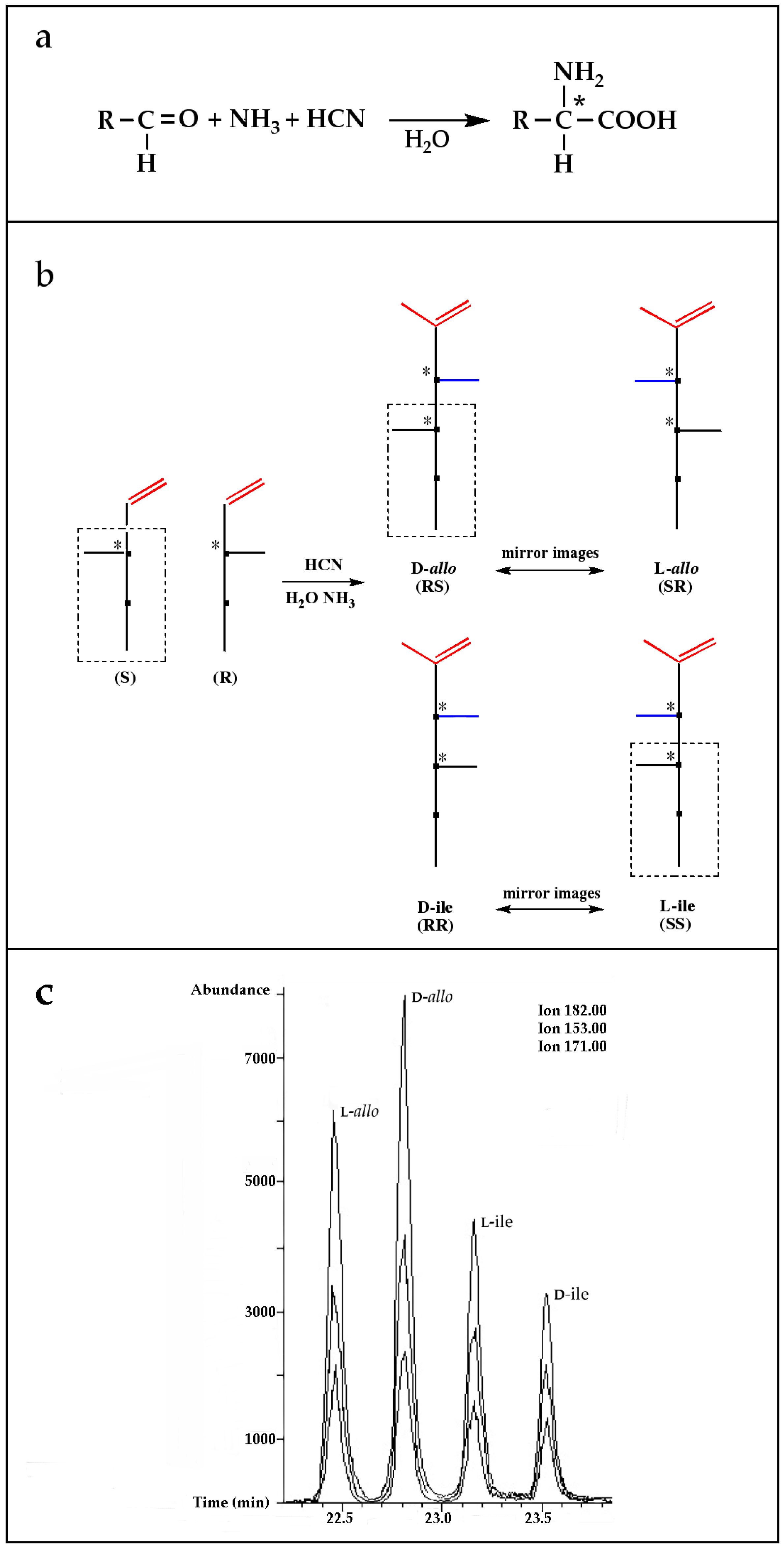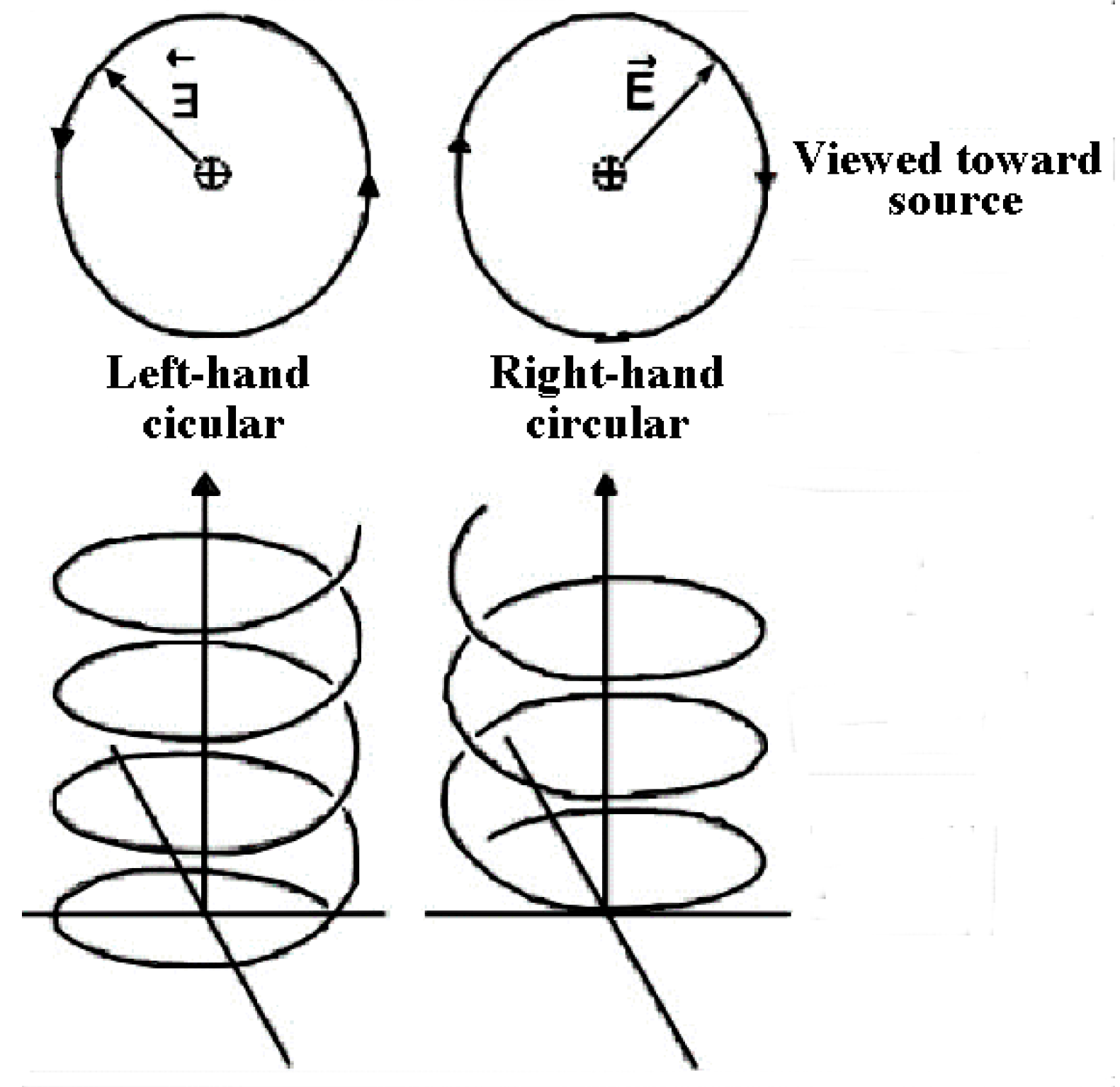Molecular Asymmetry in Prebiotic Chemistry: An Account from Meteorites
Abstract
:1. Carbon-Containing Meteorites and Cosmochemical Evolution
2. Enantiomeric Excesses in Meteoritic Compounds
3. The Likely Locals for Asymmetric Syntheses
4. Prebiotic Chiral Asymmetry and the Origins of Life
Acknowledgments
Conflicts of Interest
References
- Herbst, E.; Van Dishoeck, E.F. Complex organic interstellar molecules. Annu. Rev. Astron. Astrophys. 2009, 47, 427–480. [Google Scholar] [CrossRef]
- Schopf, J.W. Fossil evidence of Archaean life. Philos. Trans. R. Soc. B 2006, 361, 869–885. [Google Scholar] [CrossRef] [PubMed]
- Gomes, R.; Levison, H.F.; Tsiganis, K.; Morbidelli, A. Origin of the cataclysmic Late Heavy Bombardment period of the terrestrial planets. Nature 2005, 435, 466–469. [Google Scholar] [CrossRef] [PubMed]
- Strom, R.G.; Malhotra, R.; Takashi, I.; Yoshida, F.; Kring, D.A. The origin of planetary impactors in the Early Solar System. Science 2005, 309, 1847–1850. [Google Scholar] [CrossRef] [PubMed]
- Pizzarello, S.; Cooper, G.W.; Flynn, G.J. The nature and distribution of the organic material in carbonaceous chondrites and interplanetary dust particles. In Meteorites and the Early Solar System II; Lauretta, D., McSween, H.Y., Eds.; University of Arizona Press: Tucson, AZ, USA, 2006; pp. 625–651. [Google Scholar]
- Sephton, M.A. Organic compounds in carbonaceous meteorites. Nat. Prod. Rep. 2002, 19, 292–311. [Google Scholar] [CrossRef] [PubMed]
- Pizzarello, S.; Shock, E. The organic composition of carbonaceous meteorites: The evolutionary story ahead of biochemistry. Cold Spring Harb. Perspect. Biol. 2010, 2, a002105. [Google Scholar] [CrossRef] [PubMed]
- Schmitt-Kopplin, P.; Gabelicab, Z.; Gougeonc, R.D.; Feketea, A.; Kanawatia, B.; Harira, M.; Gebefuegia, I.; Eckeld, G.; Hertkorn, N. High molecular diversity of extraterrestrial organic matter in Murchison meteorite revealed 40 years after its fall. Proc. Nat. Acad. Sci. USA 2010, 107, 2763–2768. [Google Scholar] [CrossRef] [PubMed]
- Cronin, J.R.; Pizzarello, S. Enantiomeric excesses in meteoritic amino acids. Science 1997, 275, 951–955. [Google Scholar] [CrossRef] [PubMed]
- Engel, M.H.; Nagy, B. Distribution and enantiomeric composition of amino acids in the Murchison meteorite. Nature 1982, 296, 837–840. [Google Scholar] [CrossRef]
- Bada, J.L.; Cronin, J.R.; Ho, M.-S.; Kvenvolden, K.A.; Lawless, J.G.; Miller, S.L.; Oro, J.; Steinberg, S. On the reported optical-activity of amino acids in the Murchison meteorite. Nature 1983, 301, 494–496. [Google Scholar] [CrossRef]
- Pizzarello, S.; Groy, T.L. Molecular asymmetry in extraterrestrial organic chemistry: An analytical perspective. Geochim. Cosmochim. Acta 2011, 75, 645–656. [Google Scholar] [CrossRef]
- Glavin, L.P.; Elsila, J.E.; Burton, A.S.; Callahan, M.P.; Dworkin, J.P.; Hilts, R.W.; Herd, C.D.K. Unusual nonterrestrial l-proteinogenic amino acid excesses in the Tagish Lake meteorite. Met. Planet. Sci. 2012, 47, 1347–1364. [Google Scholar] [CrossRef]
- Pizzarello, S.; Wang, Y.; Chaban, G.M. A comparative study of the hydroxy acids from the Murchison, GRA 95229 and LAP 02342 meteorites. Geochim. Cosmochim. Acta 2010, 74, 6206–6217. [Google Scholar] [CrossRef]
- Cooper, G.; Rios, A.C. Meteoritic sugar derivatives: Enantiomer excesses and laboratory attempts at duplication. In Lunar Planetary Science Conference, Houston, TX, USA, 16-20 March 2015. Abstract #2993.
- Pizzarello, S.; Yarnes, C.T. Enantiomeric excesses of chiral amines in ammonia-rich carbonaceous meteorites. Earth Planet. Sci. Lett. 2016, 443, 176–184. [Google Scholar] [CrossRef]
- Pizzarello, S.; Zolensky, M.; Turk, K.A. Non racemic isovaline in the Murchison meteorite: Chiral distribution and mineral association. Geochim. Cosmochim. Acta 2003, 67, 1589–1595. [Google Scholar] [CrossRef]
- Glavin, D.P.; Dworkin, J.P. Enrichment of the amino acid l-isovaline by aqueous alteration on CI and CM meteorite parent bodies. Proc. Natl. Acad. Sci. USA 2009, 106, 5487–5492. [Google Scholar] [CrossRef] [PubMed]
- Pizzarello, S.; Huang, Y. The deuterium enrichment of individual amino acids in carbonaceous meteorites: A case for the presolar distribution of biomolecules precursors. Geochim. Cosmochim. Acta 2005, 69, 599–605. [Google Scholar] [CrossRef]
- De Marcellus, P.; Meinert, C.; Myrgorodska, I.; Nahon, L.; Buhse, T.; Le Sargent d’Hencourt, L.; Meierhenrich, U.J. Aldehydes and sugars from evolved precometary ice analogs: Importance of ices in astrochemical and prebiotic evolution. Proc. Natl. Acad. Sci. USA 2015, 112, 965–970. [Google Scholar] [CrossRef] [PubMed]
- Goesmann, F.; Rosenbauer, H.T.; Bredehoeft, J.H.; Cabane, M.; Ehrenfreund, P.; Gautier, T.; Giri, C.; Kruger, H.; le Roy, L.; MacDermott, A.J.; et al. Organic compounds on comet 67P/Churyumov-Gerasimenko revealed by COSAC mass spectrometry. Science 2015, 349. [Google Scholar] [CrossRef] [PubMed]
- Pizzarello, S.; Huang, Y.; Alexandre, M.R. Molecular asymmetry in extraterrestrial chemistry: Insights from a pristine meteorite. Proc. Natl. Acad. Sci. USA 2008, 105, 3700–3704. [Google Scholar] [CrossRef] [PubMed]
- Pizzarello, S.; Schrader, D.L.; Monroe, A.A.; Lauretta, D.S. Large enantiomeric excesses in primitive meteorites and the diverse effects of water in chemical evolution. Proc. Natl. Acad. Sci. USA 2012, 109, 11949–11954. [Google Scholar] [CrossRef] [PubMed]
- Meierhenrich, U.J. Amino Acids and the Asymmetry of Life; Springer: Heidelberg, Germany, 2008. [Google Scholar]
- Rubenstein, E.; Bonner, W.A.; Noyes, H.P.; Brown, G.S. Supernovae and life. Nature 1983, 306, 118. [Google Scholar] [CrossRef]
- Quack, M. How important is parity violation for molecular and biomolecular chirality? Angew. Chem. Int. Ed. 2002, 41, 4618–4630. [Google Scholar] [CrossRef] [PubMed]
- Balavoine, G.; Moradpour, A.; Kagan, H.B. Preparation of chiral compounds with high optical purity by irradiation with Circularly Polarized Light, a model reaction for the prebiotic generation of optical activity. J. Am. Chem. Soc. 1974, 96, 5152–5158. [Google Scholar] [CrossRef]
- Flores, J.J.; Bonner, W.A.; Massey, G.A. Asymmetric photolysis of (RS)-leucine with circularly polarized light. J. Am. Chem. Soc. 1977, 99, 3622–3625. [Google Scholar] [CrossRef] [PubMed]
- Meierhenrich, U.J.; Filippi, J.J.; Meinart, C.; Bredehöft, J.H.; Tkahashi, J.; Nahon, L.; Jones, N.C.; Sóren, V.H. Circular dichroism of amino acids in the vacuum-ultraviolet region. Angew. Chem. Int. Ed. 2010, 49, 7799–7802. [Google Scholar] [CrossRef] [PubMed]
- Nishino, H.; Kosaka, A.; Hembury, G.A.; Matsushima, K.; Inoue, Y. The pH dependence of the anisotropy factors of essential amino acids. J. Chem. Soc. Perkin Trans. 2002, 23, 582–590. [Google Scholar] [CrossRef]
- Schrader, D.L.; Connolly, H.C., Jr.; Lauretta, D.S.; Zega, T.J.; Davidson, J.; Domanik, K.J. The formation and alteration of Renazzo-like carbonaceous chondrites III: Toward understanding the genesis of ferromagnesian chondrules. Meteorit. Planet. Sci. 2015, 50, 15–50. [Google Scholar] [CrossRef]
- Meinert, C.; Jones, N.C.; Hoffman, S.V.; Meierhenrich, U.J. Anysotropy spectroscopy of chiral alcohols, amines and monocarboxylic acids: Implication for the analyses of extraterrestrial samples. J. Photochem. Photobiol. A Chem. 2016. [Google Scholar] [CrossRef]
- Hua, X.; Buseck, P.R. Unusual forms of magnetite in the Orgueil carbonaceous chondrite. Meteorit. Planet. Sci. 1998, 33, A215–A220. [Google Scholar] [CrossRef]
- Pizzarello, S.; Williams, L.B. Ammonia in the early Solar System: An account from carbonaceous meteorites. Astrophys. J. 2012, 749, 161–166. [Google Scholar] [CrossRef]
- Sandford, S.A.; Aléon, J.; Alexander, C.M.; Araki, T.; Bajt, S.; Baratta, G.A.; Borg, J.; Bradley, J.P.; Brownlee, D.E.; Brucato, J.R.; et al. Organics captured from Comet 81P/Wild 2 by the Stardust Spacecraft. Science 2006, 340, 1720–1724. [Google Scholar] [CrossRef] [PubMed]
- Orgel, L.E. The origin of life: A review of facts and speculation. In The Nature of Life: Classical and Contemporary Perspective from Philosophy and Science; Bedau, M.D., Clealand, C.E., Eds.; Cambridge University Press: Cambridge, UK, 2010; pp. 121–128. [Google Scholar]
- Cronin, J.R.; Chang, S. Organic matter in meteorites: molecular and isotopic analyses of the Murchison meteorite. In The Chemistry of Life’s Origins; Greenberg, J.M., Mendoza-Gómez, C.X., Pirronello, V., Eds.; Kluwer Academic Publishers: Dordrecht, The Netherlands, 1993; pp. 209–258. [Google Scholar]
- Pizzarello, S.; Williams, L.B.; Lehman, J.; Holland, G.P.; Yarger, J.L. Abundant ammonia in primitive asteroids and the case for a possible exobiology. Proc. Natl. Acad. Sci. USA 2011, 108, 4303–4306. [Google Scholar] [CrossRef] [PubMed]
- Pizzarello, S.; Bose, M. The path of reduced nitrogen towards early Earth: The cosmic trail and its solar shortcuts. Astrophs. J. 2015, 814, 107–1015. [Google Scholar] [CrossRef]
- Pizzarello, S.; Holmes, W. Nitrogen-containing compounds in two CR meteorites: 15N composition, molecular distribution and precursor molecules. Geochim. Cosmochim. Acta 2009, 73, 2150–2162. [Google Scholar] [CrossRef]


| Compound Formula | Compound | ee% 1 | Distribution 2 |
|---|---|---|---|
 | Sec-butylamine | (S) 0-18 | GRA 95229 3,* LAP 02342 MIL 07525 PCA 91082 EET 92049 |
 | 2amino2methylbutanoic a. 4 (isovaline) | L 2.5-19.6 | MN, MY *, Or 5 LAP02342 6,* |
 | 2amino2methylpentanoic (2methylnorvaline) | L 1.4-2.8 | MN, MY |
 | 2amino2methylhexanoic (2methylnorleucine) | L 1.8 | MN, MY |
 | 2amino2methylheptanoic | L | MN |
 | 2amino3methylpentanoic (isoleucine) | L 4-50 | MN, MY GRA 95229 LAP 02342 |
 | 2amino3methylpentanoic (alloisoleucine) | D 2-60 | MN, MY GRA 95229 LAP 02342 |
 | 2amino2,3methylbutanoic (2methylvaline) | L 1.0 | MN, MY |
 | 2amino2,3methylpentanoic | L 1.4-5.2 | MN, MY |
 | allo 2amino2,3methylpentanoic | L 2.2-10.4 | MN, MY |
 | 2methylglutamic | L 3-2 | MN |
 | Lactic | L 3.0-12-3 | MN 7,*, GRA95229 * LAP 02342 * |
 | Threonic | D | MN 8 |
© 2016 by the author; licensee MDPI, Basel, Switzerland. This article is an open access article distributed under the terms and conditions of the Creative Commons by Attribution (CC-BY) license (http://creativecommons.org/licenses/by/4.0/).
Share and Cite
Pizzarello, S. Molecular Asymmetry in Prebiotic Chemistry: An Account from Meteorites. Life 2016, 6, 18. https://doi.org/10.3390/life6020018
Pizzarello S. Molecular Asymmetry in Prebiotic Chemistry: An Account from Meteorites. Life. 2016; 6(2):18. https://doi.org/10.3390/life6020018
Chicago/Turabian StylePizzarello, Sandra. 2016. "Molecular Asymmetry in Prebiotic Chemistry: An Account from Meteorites" Life 6, no. 2: 18. https://doi.org/10.3390/life6020018
APA StylePizzarello, S. (2016). Molecular Asymmetry in Prebiotic Chemistry: An Account from Meteorites. Life, 6(2), 18. https://doi.org/10.3390/life6020018





